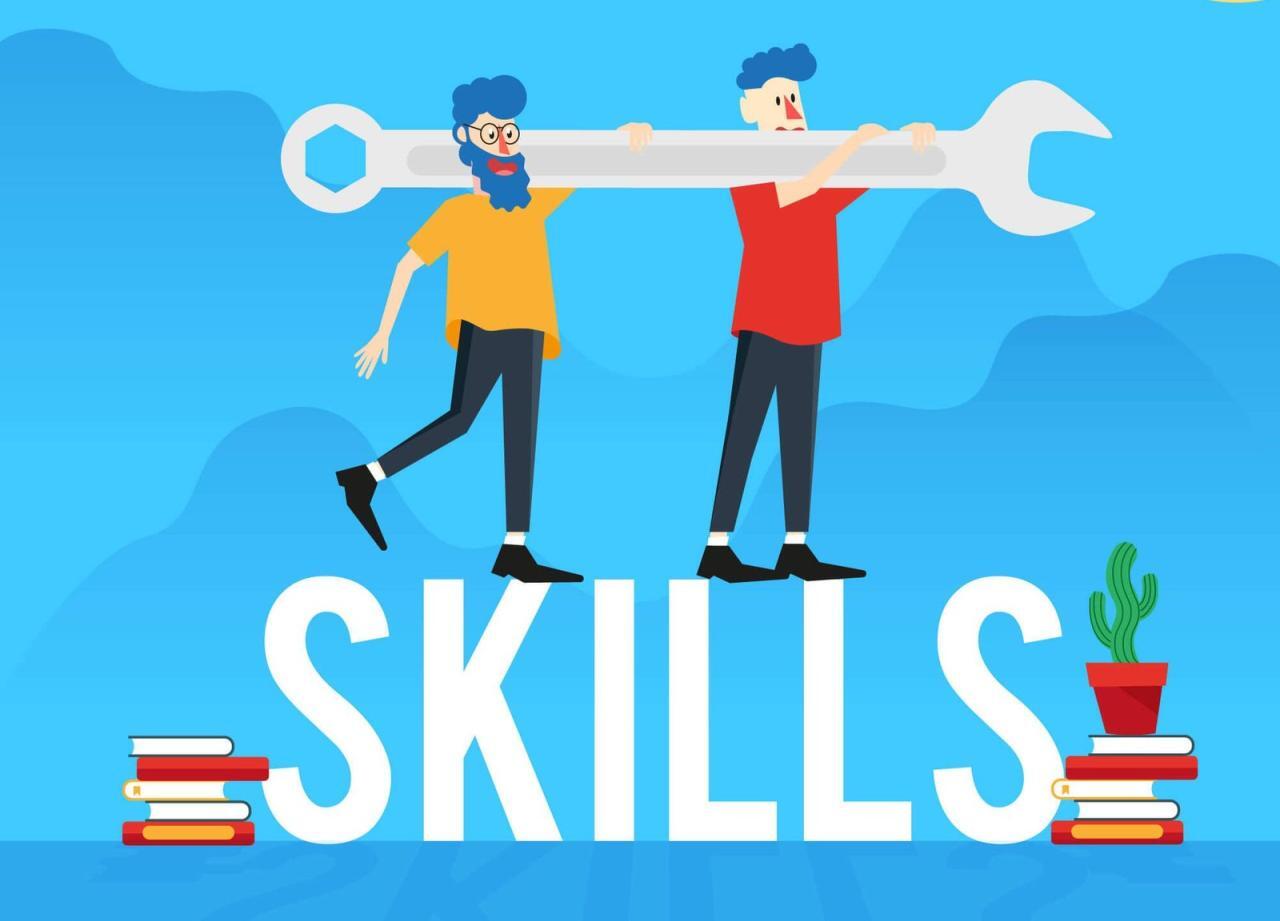This guide provides a comprehensive approach to showcasing your skills and experience, even without a traditional portfolio. It explores alternative methods, practical strategies, and valuable insights for effectively presenting your abilities in various contexts.
From online courses and certifications to personal projects and case studies, this resource equips you with the tools to craft a compelling narrative about your skills and experience. It also highlights the importance of leveraging online platforms and building a strong online presence, essential for modern skill demonstration.
Alternative Skill Demonstrations

Beyond traditional portfolios, showcasing skills through alternative methods can effectively highlight your abilities. These methods provide tangible evidence of your proficiency and often present opportunities to demonstrate a broader range of skills, beyond just project-based work. This approach can be especially beneficial for those entering the job market or seeking to transition careers, as it can effectively communicate your value proposition without relying solely on a portfolio.Alternative methods of skill demonstration offer a flexible and diverse approach to showcasing your abilities.
They allow you to highlight achievements and experiences gained through various learning and development activities, presenting a comprehensive picture of your capabilities and potential.
Non-Portfolio Skill Demonstration Methods
Various methods exist beyond traditional portfolios to demonstrate your skills. These include online courses, certifications, workshops, and volunteer work. Each provides a distinct avenue for showcasing specific skill sets and experiences.
Examples of Skill Demonstrations
| Skill Type | Alternative Demonstration Method | How to Showcase the Skill |
|---|---|---|
| Project Management | Online Courses (e.g., Project Management Professional (PMP) preparation) | Highlight course completion and relevant project management techniques learned. Include details on project scope, planning, and execution. |
| Data Analysis | Data Analysis Certifications (e.g., Google Data Analytics Professional Certificate) | Emphasize specific tools and techniques learned, such as SQL, Python, or R. Showcase projects involving data cleaning, visualization, and analysis, even if completed within the course. |
| Web Development | Coding Bootcamps or Online Courses (e.g., Full-Stack Web Development) | Detail specific projects completed during the course. Provide links to live websites or repositories, emphasizing front-end, back-end, and database development. |
| Technical Writing | Workshops and Online Courses (e.g., Technical Writing for Software Developers) | Present writing samples showcasing clarity, conciseness, and accuracy. Include documentation from projects or course assignments, highlighting your ability to communicate technical information effectively. |
Types of Online Courses and Skill Showcase
Demonstrating skills through online courses allows you to document your learning journey and highlight acquired competencies. Each type of course provides unique opportunities to showcase specific skill sets.
- Project-Based Courses: These courses often involve practical, hands-on projects, allowing you to directly apply your learning. Highlight the projects completed, outlining the problem you addressed, your approach, and the results achieved. This demonstrates not just knowledge but also practical application.
- Coding Bootcamps: Showcase the projects built during the bootcamp, showcasing proficiency in various programming languages and development frameworks. Include links to repositories or live demos of your work. Emphasize the development process, highlighting problem-solving and technical skills.
- Certification Courses: Certifying courses provide evidence of expertise in a particular area. Detail the specific skills and knowledge gained from the course and any associated certifications earned. Highlight how these skills relate to the desired job role or industry.
- Skills-Focused Courses: These courses often concentrate on specific skills, such as communication or problem-solving. Use examples from the course assignments and exercises to showcase the application of these skills. Demonstrate how these skills have contributed to your work or personal development.
- Professional Development Courses: These courses typically focus on soft skills, such as leadership, time management, or teamwork. Highlight the specific skills and techniques learned, and provide examples of how you’ve applied them in your work or personal life. Showcase improved work habits and strategies learned through the course.
Leveraging Online Platforms
Demonstrating skills without a traditional portfolio requires a robust online presence. Leveraging online platforms allows you to showcase your abilities, build a professional network, and gain valuable feedback. This approach is increasingly important in today’s digital job market, where a strong online profile can be a crucial differentiator.Effective online presence hinges on strategically utilizing various platforms, highlighting relevant skills, and actively participating in online communities.
Social media platforms like LinkedIn, coupled with specialized platforms, can significantly enhance your visibility and credibility.
Suitable Online Platforms for Skill Showcase
Understanding the strengths of different online platforms is key to creating a comprehensive online presence. Different platforms excel in showcasing different types of skills. A well-rounded approach across multiple platforms creates a more impactful and comprehensive profile.
- LinkedIn: An invaluable professional networking platform, LinkedIn is excellent for showcasing professional experiences, skills, and recommendations. It’s crucial for connecting with potential employers and industry peers. Posting articles, sharing insightful content, and engaging in relevant discussions on LinkedIn can significantly boost your online visibility and establish your expertise.
- GitHub: A platform particularly valuable for developers, GitHub allows you to showcase coding projects and collaborate with other programmers. Public repositories demonstrate coding skills, version control proficiency, and collaborative abilities.
- Behance: A popular platform for graphic designers, Behance enables you to showcase your design work, projects, and portfolio. It facilitates direct communication with potential clients and peers within the design community.
- Dribbble: Another excellent platform for designers, Dribbble emphasizes design concepts and visual presentations. Sharing your design work on Dribbble helps showcase creativity and visual storytelling skills.
- Medium/WordPress.com: Ideal for writers, these platforms allow you to publish articles and demonstrate writing skills, establishing expertise in a specific niche. A blog can showcase your writing abilities and thought leadership in a particular field.
Utilizing Social Media Platforms Effectively
Social media platforms, particularly LinkedIn, offer unique opportunities for skill demonstration. A well-maintained social media presence can significantly impact career prospects. Consistent and strategic posting can create a lasting impression.
- LinkedIn Profile Optimization: A comprehensive LinkedIn profile is crucial. A compelling profile summary, detailed experience descriptions, and relevant skills sections are essential. Highlighting quantifiable achievements and relevant s is key to attracting potential employers.
- Content Creation: Sharing articles, insightful posts, and updates demonstrates expertise and industry knowledge. Regular engagement with industry discussions enhances your visibility and builds credibility. Posting about relevant topics or sharing your own insights is a valuable way to establish expertise.
- Network Building: Actively connecting with professionals in your field is essential. Participating in relevant groups, commenting on posts, and engaging in discussions builds connections and exposes you to potential opportunities.
Creating a Compelling Online Presence
A compelling online presence requires a cohesive strategy across various platforms. Consistent branding, clear communication, and a focus on demonstrating expertise are critical.
- Branding Consistency: Maintaining a consistent brand identity across platforms, including a professional profile picture, creates a recognizable presence. A consistent brand image strengthens credibility and reinforces your expertise.
- Highlighting Key Skills: Actively showcasing your key skills and expertise through relevant projects, articles, and posts is crucial. Highlighting quantifiable achievements and accomplishments strengthens your profile.
- Engaging in Online Communities: Participating in relevant online communities and forums demonstrates your engagement and commitment to your chosen field. Contributing to discussions and providing helpful insights strengthens your presence.
Crafting Compelling Narratives

Crafting a compelling narrative about your skills and experiences is crucial when showcasing them without a traditional portfolio. This narrative acts as a dynamic, personalized introduction to your abilities, highlighting transferable skills and achievements in a concise and engaging manner. It allows you to demonstrate your competence and value proposition effectively, even in the absence of a physical portfolio.A well-crafted narrative effectively communicates your unique value proposition.
It paints a picture of your capabilities and demonstrates how your skills translate to specific situations and contexts. This approach is particularly valuable in showcasing transferable skills, emphasizing how past experiences have prepared you for new challenges and opportunities. Tailoring this narrative to specific audiences and contexts is key to maximizing its impact.
Crafting a Concise and Engaging Narrative
A concise narrative is more impactful than a lengthy one. It should highlight key accomplishments and skills, avoiding unnecessary details. Use strong action verbs and quantify achievements whenever possible to add impact and credibility. This helps potential employers quickly grasp the value you bring to the table.
Storytelling Techniques for Transferable Skills
To effectively showcase transferable skills, use storytelling techniques to connect your past experiences to potential future roles. For example, describe a project where you successfully managed a team, highlighting the leadership skills you developed. Quantify the results—did you improve team efficiency by X percent? Did you achieve Y in terms of project completion? Focus on the transferable skills rather than the specifics of the project, relating the experience to the desired role.
A compelling story resonates more deeply than a list of bullet points.
Tailoring Your Narrative to Different Contexts and Audiences
Understanding the specific needs and expectations of different audiences and contexts is crucial. A narrative tailored for a marketing role might focus on creative problem-solving and innovative thinking, while a narrative for a technical role might emphasize technical expertise and problem-solving. Research the specific company culture and the requirements of the role you’re targeting to tailor your narrative accordingly.
Adjust your language and examples to match the expected tone and style.
Questions to Ask Yourself When Crafting Your Skill Narrative
- What are my key skills and accomplishments that demonstrate my value proposition?
- How can I quantify my achievements to showcase the impact of my work?
- What are the specific transferable skills that I want to emphasize?
- What are the most relevant experiences to the roles I’m targeting?
- How can I use storytelling techniques to make my narrative engaging and memorable?
- How can I tailor my narrative to the specific requirements of different roles and industries?
- What is the overall message I want to convey about my skills and abilities?
- How can I use action verbs and strong adjectives to describe my accomplishments?
- What is the specific value proposition I want to communicate to the audience?
The above list of questions serves as a framework for reflecting on your skills and experiences. A thorough self-assessment will enable you to highlight your most relevant achievements and effectively communicate your value to potential employers.
Quantifying Achievements and Using Action Verbs
Quantifying achievements adds credibility and impact to your narrative. Instead of saying “improved team performance,” say “increased team efficiency by 15% through implementing a new project management system.” Use action verbs to describe your accomplishments, such as “managed,” “led,” “developed,” “implemented,” “achieved,” and “executed.” Quantifiable results are essential for demonstrating the tangible impact of your skills. Using concrete numbers and data is a strong demonstration of the impact of your actions.
Demonstrating Skills Through Case Studies

Case studies are powerful tools for showcasing your skills and problem-solving abilities in a tangible and impactful way. They provide a structured format to demonstrate your expertise, approach, and the results you achieved. This approach allows potential employers or clients to understand your work process and the value you bring to a project.Crafting compelling case studies involves more than simply listing tasks.
It requires a thoughtful narrative that highlights your contributions, challenges overcome, and the positive outcomes achieved. A well-constructed case study demonstrates your skills, providing a deeper understanding of your capabilities beyond a simple resume.
Creating Compelling Case Studies
Case studies offer a unique opportunity to showcase practical application of skills. They go beyond simply listing achievements; they delve into the “how” and “why” behind your success. By focusing on a specific project or challenge, you can effectively demonstrate your problem-solving abilities, project management acumen, and technical proficiency. This detailed approach builds a stronger narrative than simply listing tasks.
Structuring Case Studies
A well-structured case study typically follows a logical framework. This framework enhances comprehension and clarity for the reader. The core elements of a case study include a clear problem statement, detailed approach, quantifiable results, and insightful conclusions. This approach allows you to articulate your methodology and impact.
Problem Statement
The problem statement clearly defines the challenge or issue addressed in the project. This section should be concise and clearly articulate the problem’s scope. For instance, a problem statement might describe a specific performance gap, an unmet customer need, or a technical constraint that the project aimed to resolve.
Approach
This section Artikels the strategy and methods used to tackle the problem. This might include a description of the tools and techniques employed, the steps involved in the process, and any key decisions made during the project. This provides context and insight into your decision-making.
Results
This section presents the tangible outcomes of the project, emphasizing quantifiable achievements. For example, improved efficiency, cost savings, increased customer satisfaction, or technical advancements are all relevant results to highlight. Specific metrics and data points support the claims.
Conclusions
This section summarizes the key takeaways from the case study. It connects the problem, approach, and results, emphasizing the value proposition and impact of your work. This section should provide a succinct overview of the case study’s significance and lessons learned.
Demonstrating Project Management Skills
Case studies are excellent platforms for showcasing project management skills. You can detail how you planned, executed, and delivered a project, emphasizing key project management principles. By detailing milestones, timelines, and resource allocation, you can effectively communicate your project management capabilities. This demonstrates practical application and your understanding of project methodologies.
Illustrative Case Study Examples
- Project: Implementing a new customer relationship management (CRM) system to improve sales efficiency. Problem Statement: Existing CRM system was outdated and ineffective. Approach: Conducted research to identify the best CRM software, implemented the new system, and provided comprehensive training to the sales team. Results: Increased sales by 15% within three months of implementation. Conclusions: Demonstrates successful project implementation and impact on sales performance.
- Project: Redesigning a website to enhance user experience and engagement. Problem Statement: Existing website was confusing and difficult to navigate. Approach: Conducted user research to identify usability issues, redesigned the website layout, and implemented A/B testing to optimize user experience. Results: Increased website traffic by 20% and conversion rates by 10%. Conclusions: Demonstrates understanding of user experience principles and ability to enhance website effectiveness.
Types of Case Studies and Skill Suitability
| Case Study Type | Skill Sets | Suitability |
|---|---|---|
| Technical Project Implementation | Software Development, Data Analysis, Programming | Excellent for showcasing technical skills and problem-solving in a complex environment. |
| Process Improvement | Operations Management, Project Management, Lean Six Sigma | Demonstrates ability to identify inefficiencies, implement changes, and achieve quantifiable results. |
| Customer Service Enhancement | Customer Service, Communication, Relationship Management | Excellent for showcasing skills in handling customer interactions, resolving issues, and building relationships. |
Creating a Well-Structured Case Study
- Clearly Define the Project Context: Start with a concise description of the project’s goals and objectives. This helps the reader understand the overall context.
- Identify the Problem Statement: Precisely articulate the problem or challenge addressed by the project. This is the core issue needing resolution.
- Detail Your Approach: Provide a comprehensive overview of the steps and methodologies used to solve the problem. Include tools and techniques used.
- Quantify Your Results: Showcase the tangible outcomes of the project using metrics and data. This is crucial for demonstrating impact.
- Present Your Conclusions: Summarize the key takeaways and lessons learned from the project. Highlight the value proposition of your work.
- Maintain Clarity and Conciseness: Focus on clear and concise language. Avoid jargon and technical terms unless absolutely necessary.
Utilizing Testimonials and Recommendations
Testimonials and recommendations are powerful tools for showcasing your skills and experience when a traditional portfolio isn’t available. They provide social proof, demonstrating that others have benefited from your abilities and vouch for your competence. These endorsements can significantly boost your credibility and help you stand out from the competition.Effective testimonials and recommendations go beyond simple endorsements; they provide concrete examples of how your skills were applied and the positive outcomes achieved.
This allows potential employers or clients to understand not just your capabilities, but also how you deliver results. A well-crafted recommendation can effectively communicate the value proposition you bring to a project or role.
Collecting Testimonials Effectively
Gathering testimonials requires a proactive approach. Simply asking for feedback is insufficient. Instead, you should seek out specific examples of how your skills positively impacted a project or client. This could involve asking for specific anecdotes or experiences that highlight your strengths. These should be clear, concise, and readily demonstrate your skills.
Maintain a polite and professional tone throughout the process.
Presenting Testimonials Compellingly
Presenting testimonials effectively involves more than just copying and pasting text. The presentation should be tailored to the context. For example, a testimonial about project management skills would be best placed in a section dedicated to project management experience. Consider the layout and design of your online presence. Use visuals to support your claims.
Testimonials should be presented in a clear and concise manner. For example, use a quote format with a brief introduction, or incorporate them into a case study.
Leveraging Online Platforms for Recommendations
Online platforms offer convenient avenues for collecting and showcasing testimonials. Platforms like LinkedIn, Google My Business, and even dedicated review sites can be valuable tools. Leveraging these platforms can provide potential clients with access to recommendations in a format that is easily digestible. Building a strong online presence is critical to the effectiveness of these testimonials.
Types of Testimonials and Their Value
Testimonials come in various forms, each providing different insights into your skills. Client testimonials can demonstrate your ability to deliver on projects and manage expectations. Collaborator testimonials can highlight your teamwork skills and collaborative abilities. These examples can effectively illustrate the value you bring to any project or endeavor.
Examples of Testimonials by Skill Area
| Skill Area | Testimonial Example |
|---|---|
| Project Management | “I was impressed by [Candidate Name]’s ability to manage multiple tasks simultaneously and stay on schedule. They ensured the project stayed within budget and delivered high-quality results.” |
| Communication | “I found [Candidate Name]’s communication style to be exceptional. They were able to clearly convey complex ideas in a simple and easy-to-understand manner. This was incredibly valuable in the collaborative environment.” |
| Problem Solving | “When we encountered a critical problem on the project, [Candidate Name] immediately identified the root cause and implemented an effective solution. This saved us significant time and resources.” |
| Technical Skills (e.g., Software Proficiency) | “[Candidate Name] is a highly proficient user of [Software Name]. They quickly mastered the software and used it to streamline our workflow, significantly improving efficiency.” |
Preparing for Interviews and Demonstrations

Successfully navigating interviews and skill demonstrations hinges on thorough preparation. Understanding the format, anticipating questions, and practicing your responses are key to presenting your abilities confidently and effectively. This preparation allows you to showcase your skills in a compelling and impactful way, demonstrating your value to potential employers or clients.
Strategies for Interview Preparation
Effective interview preparation involves a multi-faceted approach, focusing on understanding the role, anticipating questions, and practicing your responses. This ensures a strong presentation of your skills and experience.
- Role Understanding: Thoroughly research the role and company. Analyze the job description, company values, and recent news to grasp the specific requirements and expectations. This deep understanding allows you to tailor your responses to the specific needs of the role and demonstrate your suitability.
- Anticipating Questions: Common interview questions often revolve around your skills, experience, and career goals. Prepare answers for questions about your strengths, weaknesses, past experiences, and future aspirations. Anticipating these common questions allows you to craft thoughtful and concise responses, highlighting your qualifications.
- Practicing Responses: Practice answering common interview questions, including behavioral questions, using the STAR method (Situation, Task, Action, Result). Rehearse your responses aloud to gain confidence and clarity. Record yourself to identify areas for improvement in your body language, tone, and delivery. This practice builds confidence and helps fine-tune your responses.
Preparing Examples of Work
Demonstrating your skills effectively requires showcasing tangible examples of your accomplishments. This demonstrates the practical application of your abilities.
- Selecting Relevant Examples: Choose examples that directly demonstrate the skills and experiences Artikeld in the job description. Highlight quantifiable achievements, such as project results, impact metrics, and quantifiable results whenever possible.
- Structuring Demonstrations: Organize your examples using a clear and concise structure, like the STAR method (Situation, Task, Action, Result). Start with a brief overview of the context, then describe the task, your actions, and the resulting outcome. This approach ensures a coherent and impactful presentation of your work.
- Visual Aids: Consider using visual aids like charts, graphs, or presentations to illustrate your work examples and demonstrate the impact of your actions. Visuals can often convey information more effectively than lengthy descriptions. This approach allows for a clearer and more engaging presentation of your skills and experiences.
Demonstrating Skills During Interviews
Presenting your skills effectively during interviews is crucial for conveying your value. Concise and impactful demonstrations will resonate with the interviewer.
- Behavioral Questions: Behavioral questions often explore how you have handled specific situations in the past. Use the STAR method (Situation, Task, Action, Result) to structure your responses. Describe the situation, your task, the actions you took, and the positive outcomes that resulted.
- Specific Skill Demonstrations: If the interview involves a practical demonstration, be prepared to showcase your skills. Practice using the tools and techniques relevant to the role. Be prepared to explain your thought process and decision-making.
- Active Listening: Pay close attention to the interviewer’s questions and comments. This shows active listening and engagement, highlighting your commitment to understanding their perspective.
Utilizing Visual Aids
Visual aids can enhance your presentations by providing a clear and concise representation of your skills and experiences. Use visuals strategically to illustrate your points and keep the audience engaged.
- Choosing Appropriate Visuals: Select visuals that directly support your message. Avoid cluttered or confusing visuals that detract from your presentation. Charts, graphs, and images can be effective choices to illustrate your points.
- Presentation Clarity: Ensure that your visuals are clear, easy to read, and visually appealing. Use appropriate fonts, colors, and layouts to maintain a professional image.
- Integrating Visuals: Integrate your visuals seamlessly into your presentation. Explain the visuals in detail, connecting them to your narrative. This creates a more compelling and informative presentation.
Ultimate Conclusion

In conclusion, this comprehensive guide provides a roadmap for successfully showcasing your skills without a traditional portfolio. By utilizing alternative methods, highlighting projects, leveraging online platforms, and crafting compelling narratives, you can effectively demonstrate your capabilities and achieve your career goals. Remember to tailor your approach to different contexts and audiences, and prepare for interviews and demonstrations with confidence.